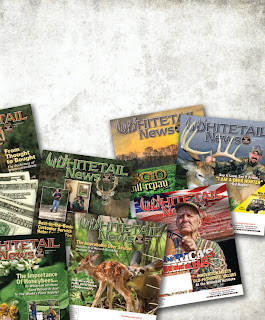If
you have a deer tag in your wallet, you’re likely a married white male between
35 and 44. You attended college, and you and your spouse earn a combined income
of $50,000 to $75,000. According to a 2006 U.S. Fish and Wildlife Service report,
you aren’t afraid to spend some of that money. The average deer hunter spent $885
on gear, guns and gadgets designed to help find, fool and kill more deer.
The
orange army is an economic force unto itself. Ten million of us spent $8.9
billion on trips and equipment in 2005, the last time the USFWS examined deer
hunter demographics and spending patterns. That’s more than the combined total
revenue of Cabela’s and Bass Pro Shops in 2013. It’s more than the entire gross
domestic product of dozens of countries. If hunting was its own corporation, it
would rank 95th on the Fortune 500 list, ahead of such giants as DirecTV, Time
Warner Inc. and Nike. By itself, deer hunting would rank higher than nearly 200
corporations on that list. Overall, America’s hunters spent a whopping $33.7
billion in 2010, an average of more than $2,500 per person on hunting-related
expenses.
The 60 or so deer hunters who book with outfitter Gene Pearcy each
season likely spend more than twice that. Like countless other outfitters who
have built businesses around America’s insatiable appetite for big whitetails,
Pearcy has made a career of helping hunters fulfill their dreams. Despite the
lagging economy, his business is thriving. He figures his clients spend an
average of $6,000 each on outfitter fees, travel, tips and other expenses. Pearcy
spends that much just on food plots each year. He’s not alone. According to a
2010 USFWS survey, hunters spent $703 million, or two percent of the total
expenditures, on “plantings.” That’s a lot of clover and chicory, and the
Whitetail Institute, which started the food plot phenomenon in 1988, has
benefitted, along with fertilizer and lime producers and many other businesses.
And one thing that isn’t talked about enough is that all wildlife benefit from this
effort and investment. “You have to remember that food plots don’t just benefit
deer and deer hunters,” Whitetail Institute Vice-President Steve Scott said.
“All wildlife that lives on the land take advantage of the food plot and
habitat work conducted by deer hunters. It’s money well spent for the
conservation community, and it undoubtedly benefits local economies, because
people who plant food plots buy fertilizer, lime and equipment from their local
farm stores.”
Our money doesn’t just go to food plots, outfitters, Cabela’s and
the hundreds of mom-and-pop hunting stores around the country. We buy licenses
that pay for the agencies entrusted to manage deer and other wildlife. Ohio
deer hunters, for example, spent more than $10 million on licenses in 2014,
nearly one-sixth of the Ohio Division of Wildlife’s entire revenue. As with
most state wildlife agencies, the money goes into the agency’s general fund,
where it is used for various purposes. However, our money is vital to their
missions, and much of it goes directly to deer management, recruitment programs and
enforcement efforts. Wisconsin has four dedicated deer biologists on staff. The
Mississippi Department of Fish, Wildlife and Parks also has four biologists whose
primary duties focus on deer management. We spend the rest of our money on
things such as leases and land purchases, which totaled $7.1 billion for
hunting in 2010. Dan Perez, who founded Whitetail Properties 11 years ago, said
the recreational land business is booming and is driven largely by deer
hunters. He started his company in response to the growing interest in trophy
deer management and hunters seeking their own place to do it.
Despite the
protracted economic downturn, Perez said plenty of hunters are still snapping
up prime deer ground in places such as Illinois, Iowa, Kansas and Missouri. Thanks
to those of us who pay for leases and buy land and countless other
deer-specific products, folks such as Perez and Pearcy have turned their
passions into careers. America’s deer hunting culture has helped turn countless
blue-collar workers into multi-millionaires and pseudo-celebrities. What deer
hunter hasn’t at least heard the names Lee and Tiffany Lakosky, Bill Jordan or
Larry Weishuhn? Perez’s entire 30-year career has revolved around whitetail
deer in one form or another. Thankfully, our passion for whitetails doesn’t
revolve entirely around money. Success can be found on a 9- acre lot. In other
words, anyone with a battered rifle, a few shells and a deer tag can participate
in one of America’s richest traditions. Some will argue that the food plot
revolution and the dedicated hunters and managers that put their time, effort
and money into food plots have created one of the most significant evolutions
in the history of hunting. No doubt, stopping market hunting and restocking of whitetails
across the country were among the most important occurrences in the history of
hunting, but food plots and the hunters who plant them are making a huge
difference economically for conservation and the benefit of all wildlife. Whenever
an anti-hunter attempts to degrade what we love, our food plot and management
efforts give us the ammunition to fire back with, “We’re putting our money
where our mouths are, plus putting in our time and effort that benefits all
wildlife.
What are you doing to provide for wildlife?” Plus, folks on the fence
who don’t hunt but are not anti-hunters will see our food plot efforts in an
extremely positive light. Hunting is a huge business, and food plots play a big
role in it, which gives us even more positive public relation benefits.

